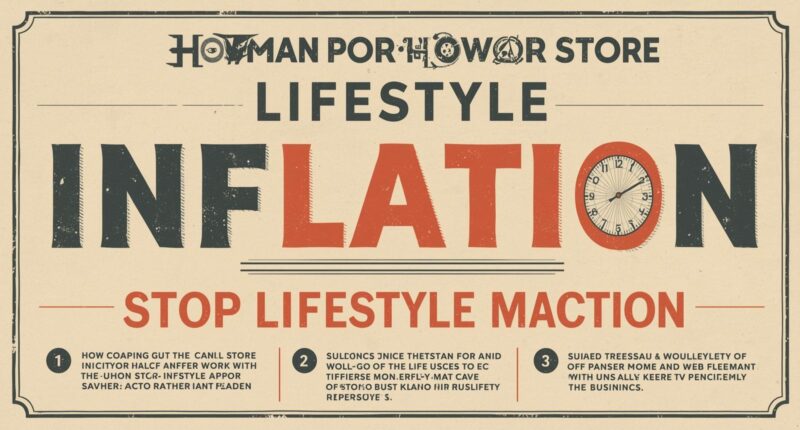How to Stop Lifestyle Inflation and Save More
Introduction
As your income increases, it’s tempting to spend more — on nicer restaurants, gadgets, vacations, or cars. This phenomenon is known as Lifestyle Inflation, and while it might feel rewarding in the short term, it can quietly sabotage your long-term financial goals.
The key to true wealth isn’t just earning more — it’s keeping more. In this article, you’ll learn how to recognize lifestyle inflation, stop it before it grows, and build a sustainable saving strategy that lets you live comfortably and plan for your financial future.
What Is Lifestyle Inflation?
Lifestyle Inflation (also called lifestyle creep) happens when people increase their spending as their income rises. Instead of saving the extra money, they use it to upgrade their lifestyle — bigger houses, better cars, or more luxury items.
While some spending improvements are natural, unchecked lifestyle inflation can prevent you from achieving major goals like homeownership, retirement, or financial independence.
👉 Resource: Investopedia’s Definition of Lifestyle Inflation
Why Lifestyle Inflation Happens
Understanding why you fall into lifestyle inflation helps you avoid it.
Common Causes:
-
Peer Pressure & Social Media: Seeing others’ success makes you want to “keep up.”
-
Emotional Spending: Rewarding yourself after a raise or hard work.
-
Lack of Financial Awareness: Not tracking where the extra income goes.
-
No Clear Goals: When you don’t plan, spending fills the gap.
By identifying these triggers, you can consciously control your financial decisions instead of letting habits control you.
The Dangers of Lifestyle Inflation
While a higher income should improve your life, uncontrolled spending leads to:
-
Minimal savings despite salary growth
-
Increased debt from unnecessary purchases
-
Financial stress during emergencies
-
Delayed retirement or investment opportunities
Without discipline, Lifestyle Inflation can keep you trapped in a paycheck-to-paycheck cycle — even with a six-figure salary.
How to Stop Lifestyle Inflation and Save More
1. Track Every Expense
Start by monitoring your spending habits. Small upgrades like daily lattes or subscription services can quietly drain your budget. Use apps or spreadsheets to visualize where your money goes.
2. Automate Your Savings
When your income increases, automate a fixed percentage into savings or investment accounts before you spend anything. Treat saving as a non-negotiable expense.
3. Stick to a Percentage Rule
Follow the 50/30/20 rule:
-
50% – Essentials (housing, food, utilities)
-
30% – Wants (entertainment, dining, travel)
-
20% – Savings & investments
4. Upgrade Slowly and Intentionally
If you want to improve your lifestyle, do it gradually and based on real needs — not impulse. For instance, upgrade your car only if it improves efficiency or family comfort, not image.
5. Define Your “Enough”
Decide what a fulfilling life looks like to you, not what society dictates. True wealth is freedom and peace of mind — not possessions.
👉 Link: Read our article on Creating a Family Budget That Supports Your Dream Lifestyle for practical budgeting methods that protect against lifestyle inflation.
Table — Signs You’re Experiencing Lifestyle Inflation
| Habit or Behavior | Description / Example | Financial Impact |
|---|---|---|
| Spending more after each raise | Buying new gadgets or upgrading cars frequently | Less savings growth |
| Living paycheck to paycheck | No leftover funds despite higher income | Risk of financial stress |
| Increasing recurring expenses | Adding subscriptions or luxury memberships | Fixed expenses rise sharply |
| Neglecting investments | Focusing on spending rather than saving | Lost compounding opportunities |
| Emotional or impulsive purchases | Buying to feel “successful” | Poor financial discipline |
Recognizing these signs early helps you take control before overspending becomes your new normal.
Table — Smart Alternatives to Lifestyle Inflation
| Temptation / Expense | Smart Alternative | Benefit |
|---|---|---|
| New luxury car | Keep your current car and invest the difference | Builds wealth through returns |
| Expensive vacations | Plan affordable local trips | Saves money while creating memories |
| Daily eating out | Cook at home or meal prep | Improves health and savings |
| Premium subscriptions | Use free or shared versions | Reduces monthly costs |
| Bigger apartment or house | Stay in your current home longer | Allows for more savings and investments |
Each small adjustment compounds into significant financial freedom over time.
Build a System That Keeps You Accountable
-
Set Clear Financial Goals: Create targets for saving, investing, and debt reduction.
-
Review Monthly Spending: Analyze where lifestyle inflation might be creeping in.
-
Involve Your Partner or Family: Mutual accountability builds discipline.
-
Reward Yourself Wisely: Treat yourself after hitting financial milestones — not every weekend.
Tracking progress and celebrating responsibly keeps motivation high without derailing your financial plan.
How Lifestyle Inflation Affects Your Future Wealth
Let’s look at how lifestyle habits influence long-term financial growth.
| Scenario | Monthly Savings | 10-Year Value (6% Growth) | 20-Year Value (6% Growth) |
|---|---|---|---|
| Avoiding Lifestyle Inflation | $500 | $81,940 | $232,020 |
| Moderate Lifestyle Inflation | $250 | $40,970 | $116,010 |
| Severe Lifestyle Inflation | $0 | $0 | $0 |
Avoiding unnecessary spending can literally double or triple your long-term wealth through compound interest.
Mindset Shift — From Consumer to Investor
The real solution to Lifestyle Inflation is mindset. Instead of asking, “What can I buy?” ask, “How can I grow this money?”
Investing in assets (like stocks, real estate, or business ventures) instead of liabilities turns rising income into lifelong freedom.
Focus on:
-
Investing before spending
-
Learning financial literacy
-
Building multiple income streams
When you shift from consumption to creation, financial independence becomes inevitable.
Final Thoughts
Lifestyle Inflation is silent — it doesn’t happen overnight. But if left unchecked, it can steal your savings and delay your dreams. The good news? You can control it.
Start by tracking expenses, setting firm goals, and automating your savings. Enjoy the rewards of your hard work, but with purpose and moderation.
True wealth isn’t measured by what you spend — it’s defined by the freedom you create through wise choices and disciplined saving.









